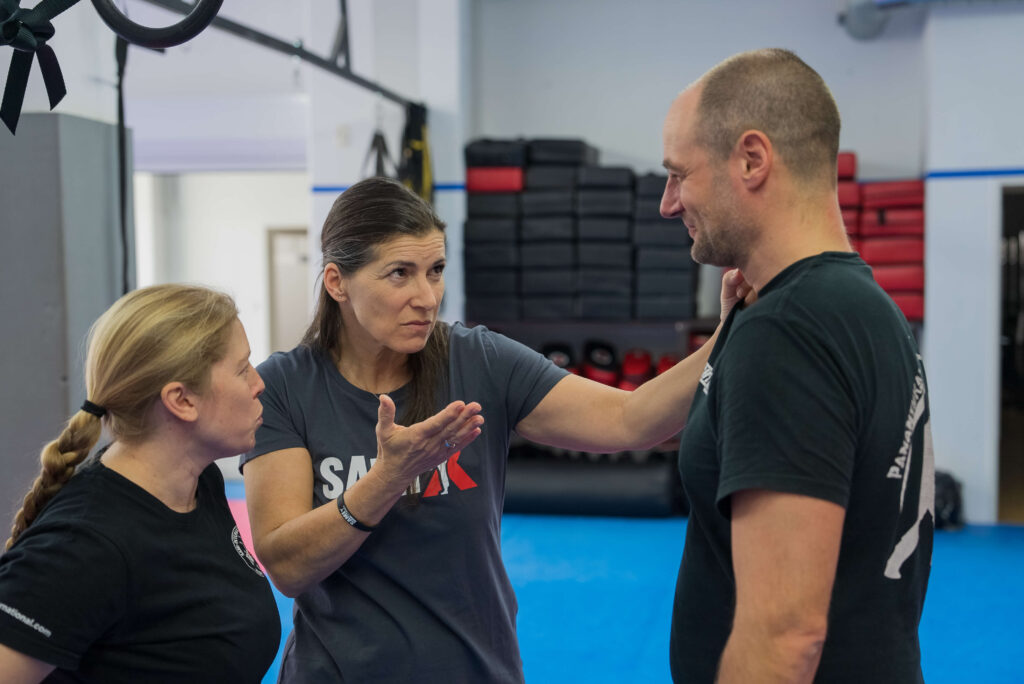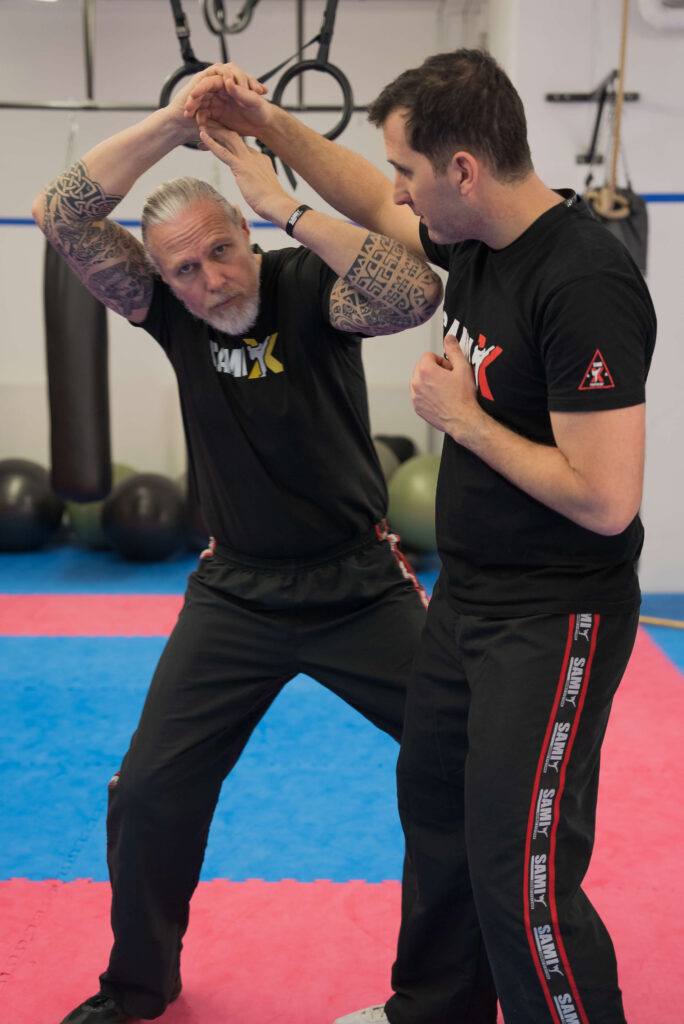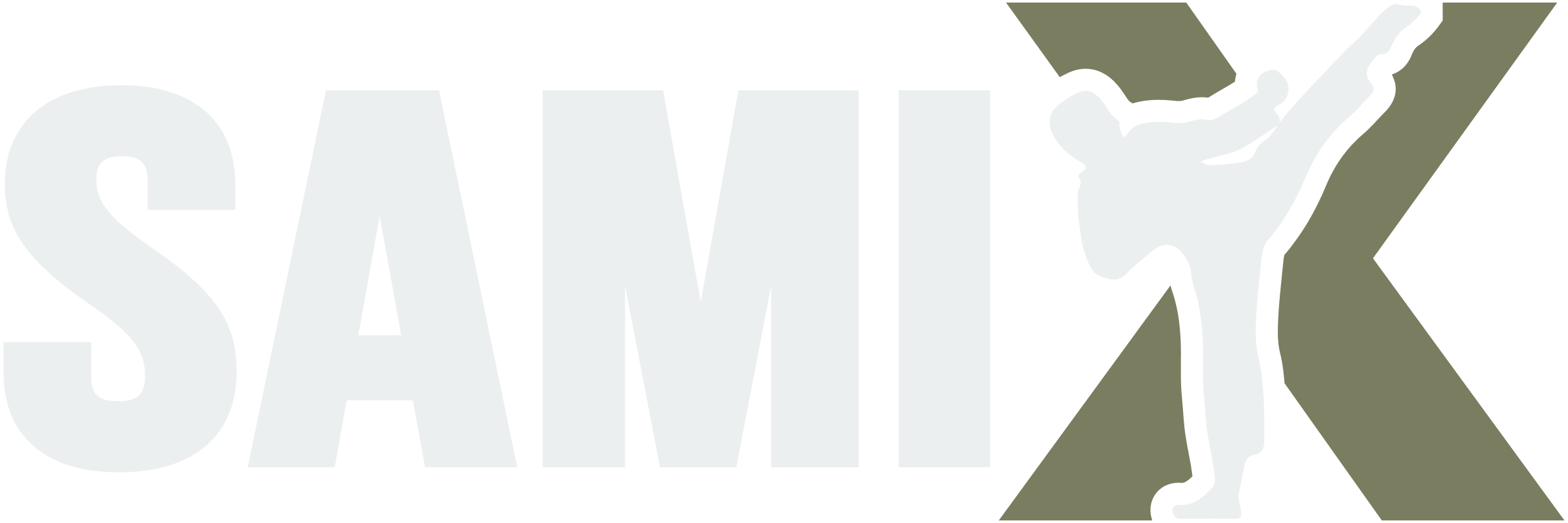SAMI-X DEFENSE
Krav Maga Concept
Origins
Krav Maga was devised by Imi Lichtenfeld in Bratislava, modern day Slovakia, in the early 1940s. After his escape to Palestine and following the foundation of the state of Israel, he became a close quarters combat instructor for the Israeli Army and taught Krav Maga there. Nowadays, Krav Maga is regarded as one of the most acclaimed and effective systems for self-defense. Krav Maga is taught to units of the Israeli Security Forces, the military, Mossad and Israeli Police Forces. The system was developed to reach maximum proficiency in the shortest time and to withstand violent situations as well as mental stress. Krav Maga focuses on improving an individual’s self-confidence, defense capability and both mental and physical fitness. Of course, Military Krav Maga has been widely modified for civilian use. These adaptations for today’s needs have made Krav Maga what it is – highly efficient and extremely practice-oriented.
Features of Krav Maga
Krav Maga combines techniques from boxing, kickboxing, knife fighting, stick fighting, Aikido, Karate, Judo, Jiu-Jitsu and many more. One principle of Krav Maga is training a person’s natural reflexes in a way that they can be applied effectively in dangerous situations of any kind. In Krav Maga you don’t have to stick to certain processes – the basics you have been taught are simply combined with additional, dynamic moves. It is this freedom to improvise that allows you fast adaptation to any given situation.
Who can learn Krav Maga?
Krav Maga was devised to train even untrained individuals to a substantial proficiency of self-defense in a short span of time. Thus, Krav Maga is basically for everyone, regardless of age or gender. Various physical conditions are not a problem. After all, anyone could be the victim of a violent attack!
Why does it make sense to learn Krav Maga?
Studying a self-defense system serves a number of purposes. First of all, you learn to deal with and handle aggression, which, in turn will improve your self-confidence. You won’t be unprepared and helpless when bad things happen to you. Overcoming fear and gaining self-assurance will improve your quality of life. One will learn to better understand dangerous situations and, as a result, to react sensibly according to the situation. Krav Maga will also help you to help others in fearful circumstances. You will learn to assess potentially dangerous situations and you will know whether it is advisable to take action or to call the police. So you learn to help and support others better. Studying self-defense will also decrease your risk of becoming a victim. Experience shows that people who display self-confidence are less likely to be victims of violent crimes than others. Should there still be a threat, people who have studied self-defense do have a realistic chance to escape unharmed.

How is Krav Maga taught?
Latest insights in training methods are taken into account. Krav Maga training is not deeply rooted in tradition but considers efficiency for the individual practitioner. In Krav Maga, there are no traditional rituals or esoteric insights, which can be found in some Asian martial arts. We don’t make a cult of people or graduation systems. The instructor is a person who helps us to broaden our knowledge of self-defense; he is not an object of admiration. It is very important for us to interact on a sensible personal level, understand the other person and create a comfortable atmosphere for our training sessions.
Krav Maga is a constantly evolving system, we strive for development and better solutions. There is no absolute truth, and we don’t claim to know everything. Some people say that they have found the ultimate technique, the universal solution that works for anybody. This is highly dubious. Experience teaches us that an effective self-defense system must be highly flexible and adaptable. Imagine a person who has physical limitations and can therefore not learn a certain move. Does this person have to practice that move over and over again just because some grandmaster says so? It makes a much more sense to offer alternatives which consider an individual’s abilities and needs. The system must be adapted to the person, not vice versa! The flexibility of Krav Maga will put physically disadvantaged people in a good position.
The Level arrangement
Our training and educational programmes are grouped in Krav Maga levels. The idea is to make lessons clear to the participants and to show which techniques are expected from them, and are, of course, required from them in higher level classes. This is done, on the one hand, in order not to ask too much from beginners, and on the other hand, in order not to ask too little from the advanced or pros. Our trainings are methodically arranged in a way that appreciable success will come quickly.

Level 1 – for beginners
Krav Maga Level 1 is open for all Krav Maga students. The aim is to learn the basics of self-defense. Various positions, steps, defense against roundhouse attacks, defense (aggressive and de-escalative) against , grapping of the hands, choking, clinching, knife attacks, basic combinations of punches and kicks, elbow- and knee-strikes are taught. The training does not only deal with the physical aspects of an attack, though. Behaviour before the fight, bluffing, distracting and fighting techniques are coordinated. Techniques which can be learned quickly and combined effectively are chosen from a vast pool.
Level 2
Level 2 is open for all Krav Maga students who have mastered Krav Maga’s basic techniques (Level 1). In Level 2 trainings, the basic techniques from Level 1 are expected and will not be practiced isolated but in combination in various circumstances, situations and positions. Another point is to apply techniques at high speed and out of reflex. Defense against straight attacks, combinations of kicks and punches, release of grapping of clothes, introduction to ground techniques and steps are taught. This is absolutely necessary in order to learn more complex techniques and defense moves.
Level 3
Level 3 is open only for Krav Maga students who have mastered Krav Maga’s techniques from Levels 1and 2. This level serves as a preparation for the Advanced Levels. In addition to various combinations form B1 and B2, the even more demanding training in Level 3 contains the defense against lateral attacks, defense against lower arm chokes, defense with every-day tools, extended defense on the ground and realistic scenario-based training.
Level 4 – Advanced Programme
Level 4 (Advanced and Expert students) is open only for Krav Maga students who have mastered Krav Maga’s techniques from Levels 1 to 3. Techniques and close-combat behaviours from all other Levels are required for Level 4. The highly demanding training in Level 4 (Advanced 1 to 3 and all Expert Programmes) contains, first and foremost, defense against armed attacks, ground fight, sparring, active use of weapons, defense against more than one aggressors, and realistic scenario-based training. The individual competences of each student are expanded in a way to allow them to react appropriately to any kind of attack. Additional topics are defense of third parties, armed threats, attacking techniques, control techniques, locks, takedowns and fixing techniques.
Level All
Krav Maga’s Level All training sessions are equally appropriate for beginners and advanced students, as the lessons contain topics from Levels 1 to 3. Combinations of punches and kicks, armed attacks, ground fight, release techniques on the ground and defense against punches and kicks are taught. Demanding punching drills build power and speed.
Krav Maga – Different Areas, different Concepts
Krav Maga is a simple and at the same time highly efficient system of self-defense which is based on instinctive moves, practical techniques and realistic training scenarios. Krav Maga is self-defense in its purest form, it’s no martial art or sport. Due to its unorthodox training methods; Krav Maga will also strongly improve its students’ fitness.
Members of some professional groups are well advised not to underestimate the risk to fall victim to aggressive customers, clients or patients. Security Krav Maga has been developed with these professional groups in mind. The team of Security Krav Maga is specialized on the education of security staff, security companies as well as individuals who encounter violent situations in their professional life.
The roots of Security Krav Maga (SKM) are both in the military as in the civilian field. Through numerous adaptations – attention to local and regional laws, proportionality of action, development from pure self-defense to the needs of professional groups – Security Krav Maga has come into being. In civilian Krav Maga, self-defense is key – add teamwork, consideration of mission and laws, vocational field, third party protection, approach techniques, fixing and transporting techniques, and some more, and you’ll have Security Krav Maga. Security Krav Maga has been developed as a tool for task forces, security staff, members of the Armed Forces, bodyguards, Police Officers and individuals who have to deal with aggressive customers/clients/guests/patients. More information: www.security-kravmaga.at
Now more than ever, children need to have the chance for physical activity, to develop dexterity and flexibility and to develop a healthy dose of self-esteem and confidence.
The specially schooled Krav Maga Kids and Youth Instructors never forget that! More contents of the training are coordination, balance and understanding of the body. It is not the aim to act out scary situations, even though understanding appropriate behaviour in dangerous environments is part of the training. The concept for self-defense for children focuses on age-oriented methods with a lot of fun! More information: www.kids-kravmaga.at

